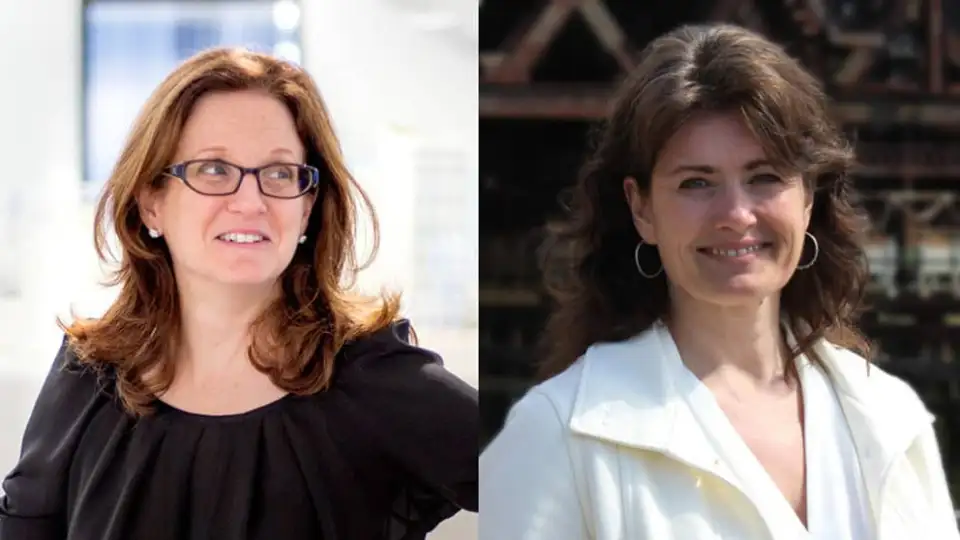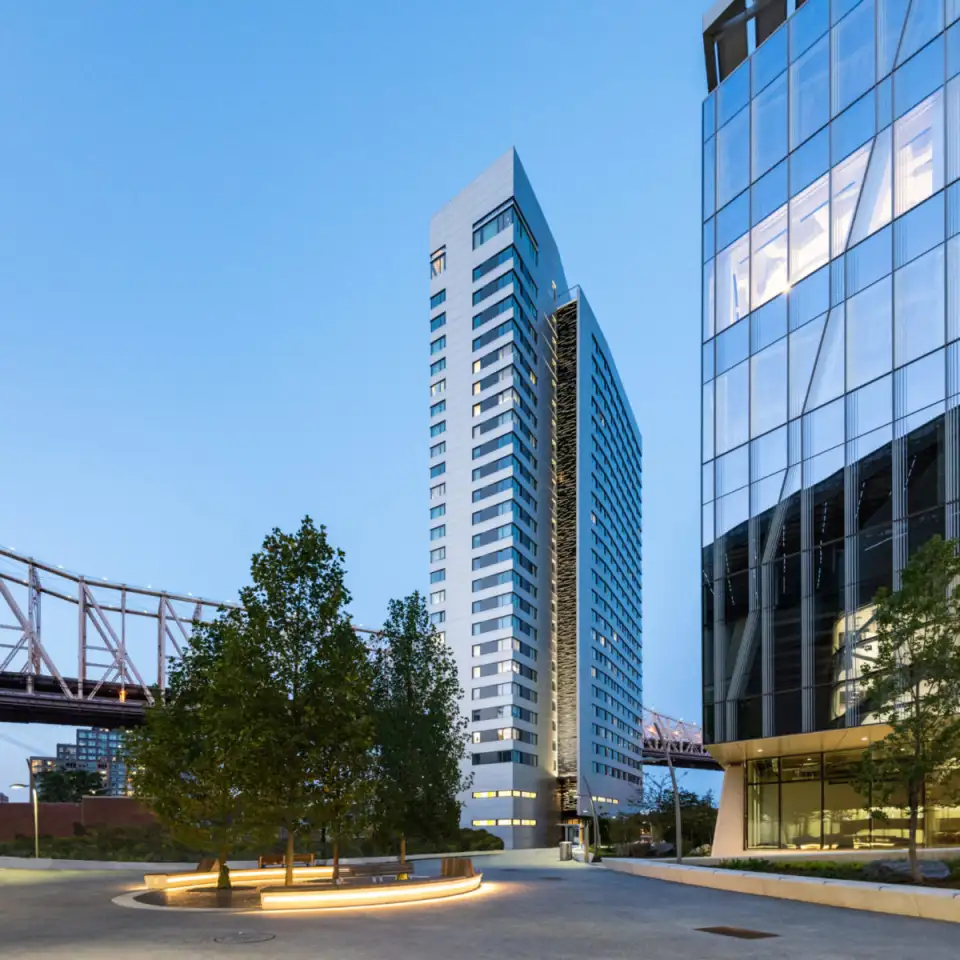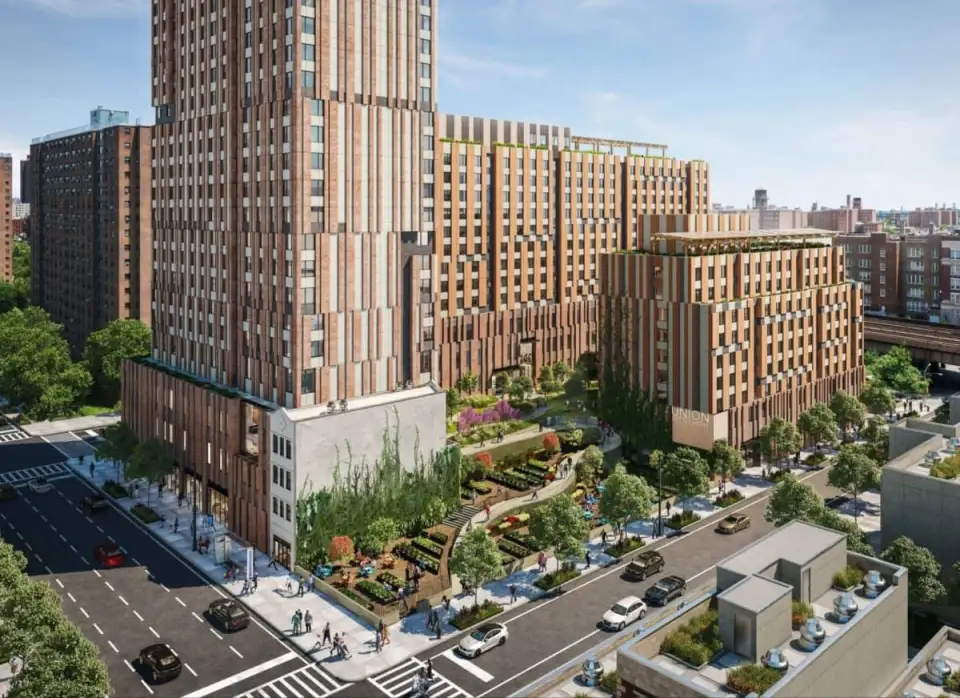
A highlight of the Passive House Canada Conference in Toronto last week was the plenary session presented by Lois Arena of Steven Winter Associates and Deborah Moelis of Handel Architects. This engineer-architect dynamic duo has been a driving force behind a wave of pioneering high rise Passive House buildings in North America, including the student housing tower at Cornell Tech’s NYC campus, the high-end residential Winthrop Center in Boston, the affordable housing community Sendero Verde in East Harlem, and the student residence at University of Toronto Scarborough (site of the Passive House Canada Conference this year).
Their talk, “Passive House on a Large Scale,” charted the team’s learning curve, shared lessons learned, and encouraged new practitioners to jump in and get their hands dirty: an inspiring, can-do message. Passive House Accelerator’s Michael Ingui and I were pleased to get the chance to sit down with Lois and Deborah for this chat.
Zack: You guys are Passive House rock stars, and you’re doing some of the most significant projects around anywhere, certainly in North America. One of the themes that really shone through in your presentation was that everyone can do it, and that you have this journey that started with Cornell Tech, and has since moved on to new projects. Maybe you could start with how your journey in Passive House has been and what advice you have for others.
Lois: It’s been quite the journey. It’s almost like everybody involved in these groundbreaking projects, you’re almost like research scientists. Someone’s throwing a problem at you and you’re like, we can figure that out. Everybody has the same mentality: “We can figure that out.” That’s what we do. We’re problem solvers. And it’s really step by step: What’s the problem and how do we get, not around it, but how do we address it? And sometimes there’s no direct way, there’s no direct example, and you need a waiver or a bye on that for this time around, but everybody knows that that needs to be addressed. This lack of information or lack of equipment has allowed industries to step up and to bring new projects into the market where we’re lacking.
Some areas are still lacking, but some have exploded. There’s been this great growth in a really short period of time. In six years, we’ve seen changes in windows and thermal break materials, ideas, and solutions. It’s been an exponential growth in knowledge, I think. That’s my perspective.
Michael: Yeah, I feel the same. It’s pretty amazing.
It’s kind of insane to think that the work that we’re doing, that we’re all doing here at this conference, has a potential to really change the world.
Deborah: I would echo everything that Lois was saying. I’m not a scientist. It was not my life’s dream to do this work. It was something I discovered pretty late in life, but it just changed my life. It’s changed the way I interact with my own kids, and I feel I can now really have an effect on potentially doing my part to actually help the world. It’s kind of insane to think that the work that we’re doing, that we’re all doing here at this conference, has a potential to really change the world. We’re doing our part. We’re trying. And, for me, that’s been such an amazing part of the journey, and completely a surprise. This whole thing is quite a surprise to me.
I was not a person that signed up for this. It really came to me, but it became something that I got a passion for, and now it’s just my way of really trying to help solve the problem. It’s fantastic. It’s such a great opportunity for us that there’s something we can do because you can’t just sit idle. We actually have something that we can do to change this problem. We are like the snowplows. We’re just paving the way for other people to do it behind us. And there’s no reason why they won’t.
You know, LEED, when it started, everyone was all crazed about LEED. And now it’s completely business as usual, and the same thing will happen here. So, I think just being able to have an impact on the world…how incredible!
Lois: It’s humbling, isn’t it?
Deborah: It’s such an incredible opportunity.
Lois: Being invited to a conference to speak, to share your knowledge, you’re like, “Me?” Like, “Me?” You want me to come talk to you? Okay. All right. I’ll come. But it’s very humbling, actually. It’s lovely. It’s quite lovely.
Deborah: It’s really incredible. Everyone’s so open and I feel like sharing is so important. And being able to have something that you can share, that people really want, is just such an honor. I really have to give credit to my company for giving me the space to learn this, even if we have not been terribly profitable…
[Laughter]
Zack: The hazards of being on the bleeding edge.
Deborah: Right.
Michael: But it makes a difference for everybody else coming after you…they’ve learned so much, which is crazy when you think about what you’ve done. There are so many people who are learning from you. Openly sharing—like you just did and have done in other presentations—your knowledge so that others coming after you aren’t going to make the mistakes that you learned from is very important, and all the solutions that you’ve tried hard, probably very painfully, to create…it’s been very nice to see. You guys have been very open about sharing your info.
Lois: Thank you. We try to be.
Deborah: I think that’s the community we’ve fostered. I think also the community, the Passive House community, is very open and very sharing.
Lois: I agree.
Deborah: I think that’s the only way that all this…somewhat complex knowledge can be disseminated.

Zack: So, as an architect, how has Passive House changed the way that you design or think about design? How has it influenced your practice?
Deborah: It’s a bit of struggle. I try not to let it take over because there are a lot of other aspects that I need to be thinking about, and sometimes my decision-making process does get clouded by a certain amount of restraints that potentially are put on me, and I really don’t want that to happen. I try to balance out the design—whether they’re asking for larger windows or pushing for that corner window—and I try really hard to be open with them, and not say, “Oh, no, you can’t do that.”
The other day someone wanted a corner window, and I’m like, “Oy.” Okay. Corner window. And sure enough, we found a Passive House certified corner window, and so he gets his design vision. My job is really to help a lot of the design vision, and I really don’t want to be a person that’s squashing that in any way.
Lois: I agree.
Deborah: And I think Steven Winter Associates really supports this. They don’t want to be doing that, either.
Lois: Well, just from a personal perspective, I don’t want to live in a house with no windows, right? There are so many other health and mental benefits from light and space and air, so the balance of it is really important to me just as a person, so I totally understand when an architect wants it. It’s when you start to get the questions like, “Can I do an all-glass building?” And then you have to just consider the intelligence of that question. You don’t want an all-glass building. It’s a ridiculous building. There’s no protection, there’s no thermal protection. Drive by an all-glass building, how often do you see the shades up? Let’s use our brains. No one wants an all-glass building.
Michael: Look at a building like the U.N. It looks like a glass building, but it’s only glass on the east and west sides. Probably still not the best.
Deborah: See, there are extremes in the design psyche that aren’t rational, and so you have to balance those with rational concerns for comfort and occupant health. There are a lot of things other than energy.
Michael: In your presentation you had mentioned that getting product is still potentially a major issue. Have you seen a big difference in that? And if you could have products that were certified, what would they be?
Lois: ERVs: small, big, medium, large…I don’t care, give me some ERVs to choose from. I basically have one or two choices whether it’s centralized or individual or in-suite units. We do not have good choices in the United States—not enough to make the bidding competitive or to give options to the architects and the engineers on how to handle the situation. That’s the biggest constraint we have.
Windows are better. We have ten-fold the windows now than we had five years ago. It’s unbelievable. We’re still restricted on aluminum, but otherwise there are many other choices: fiberglass, uPVC, some good aluminum. We’re starting to see storefront and we’re starting to see curtain wall manufacturers get on board, so that’s been beautiful. Thermal break products, too. There are a lot of different things coming in.
Mechanical, we’re still short. Any cold climate, domestic hot water heat pumps out there, that can handle this climate? Come to the United States. Please, come!
[Laughter]
Lois: That’s what we’d like to see.
Deborah: I think also the magic bullet is a unit that can go into a PTAC sleeve, a VRF that can go into a PTAC sleeve. If someone did that, it would change New York City’s footprint overnight.
By 2050, approximately 800,000 buildings need to be retrofitted. It’s mindboggling. We’ve talked to Mitsubishi; we’ve talked to some people I know. Everyone’s trying to figure it out, even Gary Handel. He’s trying to draw it at his desk. You know. We’re all trying.
It’s going to happen. If you can put a man on the moon, you can make a PTAC-sized VRF.
[Laughter]
Deborah: So that will solve a lot of our problems. To me, that’s the magic bullet. Additionally, all these other materials, watching their websites mature has just been incredible. And watching Steven Winter’s spreadsheets get longer with choices of things is great.

Zack: What is the next building type you guys want to do as Passive House? Or what’s the next challenge? Are you at a place where you want to take the next challenge? Or are you at a place where you can do the same thing for a while?
Lois: We’re gluttons for punishment. Honestly though, we have a couple of projects in the works right now that are filling this void, we think. We can’s say them publicly yet, but it’s hotel, and I think hotel is the perfect Passive House client. There’s a need for quiet not just from the exterior, but from mechanicals. From any angle—comfort, quiet, energy efficiency, hot water use—hotels are perfect clients for Passive House. I think it’s going to take off in that sector once the first one in the United States goes up and we start to publicize it.
Deborah: We’re also really interested in Passive House senior housing. That’s another huge market and potentially they don’t require the sort of showboat massive windows. We really have to get people away from that mindset. If you walk into your friend’s apartment, and if they have big windows, you have to say, “What is wrong with you?” You know? We have to get to that point in society where that’s just wrong.
[Laughter]
But I do think senior housing, which is a much-needed product in New York in particular, I think that’s just waiting. Very easy, very easy.
Lois: I think the other client that is so right for this and we’ve seen it more and more, are universities like University of Toronto. It’s not just because of their new products and their students are demanding it—because the new students are really wanting sustainability—but because they have campuses of old buildings that are so inefficient and need so much help. For instance, SUNY is one of the largest landholders in the state of New York, and for New York to meet their carbon reduction goals, SUNY has to be onboard 100 percent. They have portfolios of buildings that need to be addressed.
So, universities are really key in trying to meet our carbon reduction goals worldwide.
Michael: One final question: There are so many architectural firms in New York City that are not doing Passive House yet. If someone was just starting and they saw your presentation, and they were like, “Wow, maybe I could do that!” Do you have any recommendations for them of how to start their first one and what they might do?
Deborah: Call Steven Winter.
Lois: Or Handel.
[Laughter]
Michael: That is typically my answer. In my presentation before, I said, “If you’re going to start, it’s very simple: outsource.”
[Laughter]
Lois: So, we would say, get connected to the Passive House community. Find out who’s doing trainings near you, find out who your consultants are in the area, find out who your architects are in your area. Go on the Passive House websites and look up projects and find out who the project teams are, and connect with those people because they’re going to come to your offices, they’ll talk to you, they’re going to tell you what the challenges are, and how you beat those challenges. Just take the first step. Just call someone to come give you more information and they’ll come.
Deborah: I remember I went to one of my very first Passive House conferences and Tomas O’Leary gave me this little cardboard house, and it had all these calculations all over it. They used to hand them out, the Passive House Academy. And I thought, “What is this thing and what are all these calculations, and what in the world is this?” I will never know all of these, right? Never.
And so it was one step at a time, just like Lois is saying. I got certified, and, yes, we did have the opportunity of Cornell, but there are other opportunities out there, and you have to seize them. Also, just try to get one detail in your next project. One of these thermal break details, for example, and test it out. You have to do it yourself. No one is going to tell you necessarily exactly what to do. You must do the research and just get it in there and try it.
Lois: One thing that works for a lot of people who are really interested is just have a feasibility study done on one of your projects. Have them take one of your projects and see what does it take to take this project to Passive House. It changes the world for them when they realize that it’s not that hard. We don’t have to change that many things, and it’s all available in the marketplace today. All we have to do is a few tweaks.
Zack: I really appreciate that message that you guys bring. Clearly, this is not easy stuff, but the message that this is doable is important to get out there. The opposite, that we do this because it’s hard, may be kind of be internally satisfying, but that’s not going to catch fire.
Lois: We’ve done it with off-the-shelf components. You can do it, too.
Deborah: Yeah. You’re going to have to.
Michael: Very true.